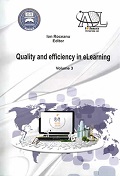OPEN SOURCE SOFTWARE USED IN E-LEARNING SYSTEMS WITH APPLICATIONS IN WEAVING
OPEN SOURCE SOFTWARE USED IN E-LEARNING SYSTEMS WITH APPLICATIONS IN WEAVING
Author(s): Adrian Buhu, Liliana BuhuSubject(s): Education
Published by: Carol I National Defence University Publishing House
Keywords: weaving; e-learning; eXe Learning
Summary/Abstract: Study of weaving processes requires knowledge of many phases of processing and phenomena’s. Traditional approach to teaching these processes has the disadvantage of a presentation largely of information not directly corresponding with the real phenomenon (understanding sectional warping phases). For this purpose requires the use of multimedia presentations for the connection between information and the phenomenon described. These presentations can be made classical, in the course room, but for better depth can use different e-learning systems. The purpose of this paper is to present several open source solutions that can be applied to study the processes of weaving (eXe Learning, Hot Potatoes, and so on). This software can be used to create interactive courses that the student may approach based on complexity. In the case of eXe Learning can be generated courses which have a similar structure to that of the classic course, but that can be approached as a web page. Information is structured so that they comply with the requirements of a weaving technology. The teacher can generate in the same course, a number of subsections which the student can learn in the same order or according to his need. Can be attached multimedia materials, its own teacher, and reference may be made to the existing materials on the Internet. The software has the possibility to generate tests with the answers that have the disadvantage that the order is the same, but you can use special software to test for generating (like Hot Potatoes). The course can be saved in different formats so it can be uploaded on a platform of e-learning or may be used independently, without access to the Internet (with saving multimedia materials to another medium), etc.
Journal: Conference proceedings of »eLearning and Software for Education« (eLSE)
- Issue Year: 9/2013
- Issue No: 03
- Page Range: 434-439
- Page Count: 6
- Language: English

